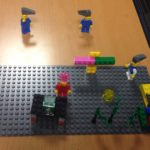NILE is integrated into the Active Blended Learning (ABL) process at The University of Northampton and we need to ensure that it is being used effectively by staff in order to provide a quality student experience.
Building on the guidance which was initially produced in January 2012, the framework has now been updated to cover the minimum standards which are expected on a NILE site. This was approved at University SEC in March, 2020 and is subsequently being used as the basis for the new NILE templates which have been developed for the 2020/21 academic year.
Guidance is also provided on how to set up NILE courses for the upcoming academic year?
 NILE is integrated into the Active Blended Learning (ABL) process at The University of Northampton and we need to ensure that it is being used effectively by staff in order to provide a quality student experience.
NILE is integrated into the Active Blended Learning (ABL) process at The University of Northampton and we need to ensure that it is being used effectively by staff in order to provide a quality student experience.
Building on the guidance which was initially produced in January 2012, the framework has now been updated to cover the minimum standards which are expected on a NILE site. This was approved at University SEC on 28th February, 2018 and is subsequently being used as the basis for the new NILE templates which have been developed for the 2018/19 academic year.
 The move to Waterside is fast approaching, and there are a number of important deadlines this year for us as staff members getting ready for the move. With this in mind, here’s a quick timeline that tries to pull together what’s happening when in preparation for the move. It’s intended to help you see what help is available to you, to support you in meeting these deadlines, and also how you might be able to use some of this work towards another target many of you have for the year – gaining your HEA Fellowship.
The move to Waterside is fast approaching, and there are a number of important deadlines this year for us as staff members getting ready for the move. With this in mind, here’s a quick timeline that tries to pull together what’s happening when in preparation for the move. It’s intended to help you see what help is available to you, to support you in meeting these deadlines, and also how you might be able to use some of this work towards another target many of you have for the year – gaining your HEA Fellowship.
Download the map: Supporting key milestones towards Waterside [PDF]
Of course, different members of staff will have different targets and priorities, and not all of these are reflected here. Some Faculties and subject groups might also have their own internal deadlines for institutional projects like the UMF Review, so always check if you’re not sure. We’ve tried to capture the ones that are generally relevant to most academic staff, but if we’ve missed any, please let us know!
I want to change my programme structure…
I want to include a placement / work-based learning / a Changemaker challenge…
I want to use a particular assessment or technology…
I want to ensure an equivalent experience for students at other sites…
What do I need to do?
The Learning Design team have collated a document listing the most frequently asked questions from CAIeROs and consultations over the past two years, along with answers provided by the appropriate support teams. Hopefully the guidance here can help you identify the processes and teams that are in place to support you with a range of course design issues including quality assurance, assessment, distance learning and technology issues.
The list has been added to the Sharing Higher Education Design (S.H.E.D.) site on NILE. You can access the site at http://bit.ly/SHED-NILE, but you will need to be enrolled to view the document.
We’ll keep this document updated as new questions and answers come up. Want to submit a question that we haven’t covered? Just email it to the Learning Design team at LD@northampton.ac.uk.
 NILE is integrated into the learning and teaching process at The University of Northampton and we need to ensure that it is being used effectively by staff in order to provide a quality student experience.
NILE is integrated into the learning and teaching process at The University of Northampton and we need to ensure that it is being used effectively by staff in order to provide a quality student experience.
Building on the guidance which was initially produced in January 2012, the framework has now been updated to cover the minimum standards which are expected on a NILE site. This was approved at University SEC on 20th April, 2016 and subsequently used as the basis for the new NILE templates which were developed for the 2016/17 academic year.
As noted at SEC on the 24th February, it was proposed to enhance the provision of NILE sites for students in four key areas during 2016/17:
- To respond to on-going staff and student feedback to enhance sites to reduce queries. Colour schemes and other features to enhance accessibility will be addressed where possible.
- To use external data where available to reduce manual setup / checking. Staff will be automatically added to sites where possible based on data from the previous year. Prompts to set up assignments in the “Submit your work” area will provide information sourced from the Curriculum system.
- To provide clean sites and work in central teams to work in partnership with tutors to only copy over required information. This will reduce storage needs and also reduce chance of displaying old information on sites. Specific days will be provided for academic teams to work with Learntech to copy content from the previous year and look at ways to enhance existing and new materials.
- Use of Learntech, CfAP, Academic Librarians, Curriculum and Records teams to work with tutors to ensure sites are ready for 16/17 delivery. Sites will be merged where feasible to reduce the total number of sites viewed by tutors and ensure that students are not left on sites which are not being used for delivery.
On 17th March, 2016, Roy Wallace (Senior Lecturer in Media Production – School of the Arts) was presented with the Best NILE Site Award as part of the Student Teaching and Representation (STAR) Awards evening.

(left to right) Roy Wallace collecting his award from Rob Howe (Head of Learning Technology)
.
The full report on the event produced by Student Union President, Victor Agboola noted that NILE is now an ‘essential part of the student online experience’. he went on to note that ‘…a prominent theme found in the nominations was that students recognised the value in a regularly updating NILE sites. Students praised the lecturers who upload the lecture content before the lecture even takes place, and having the sites well-organised throughout the year. It was found that students then had the opportunity to do some wider research which then allows them to contribute more in both lecturers and seminars.’ Some of the student comments on each of the nominees is also available
The other tutors who were highly commended within this category were:
- Anoop Bhogal Nair – Northampton Business School
- Tony Smith Howell – School of Education
- Claire Allen – School of the Arts
- Greg Spellman – School of Science & Technology
- Simon Sneddon – School of Social Science
 The honest answer to this question is, ‘it depends’. A good NILE site will de different depending on your subject, mode of delivery, level of delivery, and various other factors. As you’d expect, as much as possible we like to avoid the idea that a one-size-fits-all approach is possible to learning design. However, what is sometimes useful when trying to come up with ideas for things to do in NILE is to look at what other people have been doing. To make this easier, we have collected together a few sites which we feel are quite interesting, and have made them available as self-enrol (and self-unenrol) NILE organisations.
The honest answer to this question is, ‘it depends’. A good NILE site will de different depending on your subject, mode of delivery, level of delivery, and various other factors. As you’d expect, as much as possible we like to avoid the idea that a one-size-fits-all approach is possible to learning design. However, what is sometimes useful when trying to come up with ideas for things to do in NILE is to look at what other people have been doing. To make this easier, we have collected together a few sites which we feel are quite interesting, and have made them available as self-enrol (and self-unenrol) NILE organisations.
If you’d like to have a look at any of these sites, just do the following:
1. Log in to NILE
2. Click on the ‘Sites and Organisations’ tab
3. Search in the ‘Organisation Search’ box for either, LTC, SSAS, PSAS, CRIT101
4. Enrol on the site
Currently there are four NILE sites available as self-enrol organisations. These are:
• Let’s Teach Computing (LTC)
• Study Skills for Academic Success (SSAS)
• Postgraduate Skills for Academic Success (PSAS)
• Critical Thinking – A Practical Introduction (CRIT101)
If you’ve got a good NILE site and would like to make it available as a self-enrol organisation please get in touch with us at: LD@northampton.ac.uk
And finally, if you think that you’ve got a great NILE site, you might like to enter it for a Blackboard Exemplary Course Award: http://blackboard.com/ecp
Or, how can Lego help you to build a course or module?
Introduction to Programme Design is a one hour staff development session for new academic staff. The session covers key information that staff need to know about how programme and module design works at the University, including signposts to the frameworks and regulations and an overview of the support available.
To help staff start thinking about the complexity of course design, we gave them some lego and asked them to work in pairs to think about the elements that need to be considered, and how they relate to each other.
Why lego?
Why not? Lego is a simple to use, non-threatening tool that helps to externalise people’s ideas in a visual way. It provides a framework for storytelling, and as you will see from the results below, can help teams to synthesise and communicate big ideas. It’s used in many companies as part of a design thinking approach, to help find creative solutions to complex problems*.
Here are some of the elements that Lego helped us to discuss. Each team was given a standard set, along with a single ‘random’ piece. Click on the thumbnail images to view the full scenes:
This team used the lego to show the lecturer and students working within and co-creating a framework, which included other elements like NILE and QAP. The bridge between the students indicates social learning. The scene also includes ‘steps to success’ and a diving board to launch them into their career. The little eyes indicate institutional oversight, and the web is used to catch the students who are not engaged and enable them to ‘bounce’ back in to the course.
This scene has a student at the centre, as the course design starts from their expectations and needs. Alongside the student is an academic and a member of support staff, indicating working in partnership. The shark is about risk: in the form of competition from other universities, and of distractions from learning – the wall is a protection against this. The raised platform indicates student support, including academic standards, facilities like NILE and IT, and skills for employability.
Stakeholders in this scene include service users and commissioners, who are central to programme design for Health courses, as these must consider the needs of the local area in terms of health provision. Other elements include the resources available (lecturers, skills), and the constraints e.g. professional body regulations and quality frameworks. The elephant is Waterside, which will have a ‘massive’ influence on how we move forward with programme design.
The students in this depiction were widely scattered around the room, indicating the ‘geographically dispersed nature of learning communities’. They are connected by mobile devices. The staff member has a movable ‘office’ (which could be at home, a hotdesk, overseas etc). There are signposts for learners throughout the course. The purpose of the course is to help students achieve educational, career and social mobility, indicated by climbing the ladder.
In this scene, the students (on the left) arrive at different levels and some progress faster than others. The programme lead is looking towards them to help them progress. Ahead is the University management and governance, leading the direction of the University. The horse is University strategy, leaping obstacles and providing support to students. On the right is a platform – both for celebration of success (award ceremony) and as a launchpad to a career.
The exercise helped participants to start thinking about the stakeholders that need to be considered in programme design, the aims of their programme or module, and the ways that students are supported. The discussions showed the complexity of the course design process, and shaped our conversations about how it should be supported.
If you were in this session and would like to expand on your model, or if you weren’t but you’d like to respond to the models (or create your own!), please leave us a comment below.
To sign up for a session, visit the Staff Development organisation on NILE (note: you will need to be logged in to NILE for this link to work).
*Although we didn’t have time to use it in this session, the Lego Serious Play website outlines a full methodology for this approach.
Q: How do you eat an elephant?
A: One bite at a time!
 The move to Waterside can seem as if it isn’t really that long away, given all that you may feel you have to do inbetween now and then. Wondering where to start can also seem daunting and the mountain of work that you see ahead of you can be so huge that you can’t even see the summit, let alone work out a route to the top.
The move to Waterside can seem as if it isn’t really that long away, given all that you may feel you have to do inbetween now and then. Wondering where to start can also seem daunting and the mountain of work that you see ahead of you can be so huge that you can’t even see the summit, let alone work out a route to the top.
In supporting staff to get to grips with the course redesign implications that are predicated on a number of guiding principles about how learning and teaching will look, the Learning Design team came across a really useful set of blog posts by Tony Bates, a Canadian Research Associate who is also President and CEO of Tony Bates Associates Ltd and who, according to their website are “a private company specializing in consultancy and training in the planning and management of e-learning and distance education.”
The blog posts were written to help people understand and implement a series of practical steps to help deliver quality in their online learning materials. While I don’t wish to duplicate the posts here, I thought it might be helpful to summarise some of the key points in an attempt to help you to start thinking about how you might begin to eat your own elephant, or climb that mountain. I found some obvious points in the posts, some practical and straightforward suggestions and some real gems. There are also some questions and exercises to get you started along the road to redesigning your own modules.
I should also preface this post with the reminders that, as an institution, we are definitely NOT going fully online but will be exploring ways to enhance our learning and teaching using technology and that the precise nature of each blended module is for staff teams to determine.
The Nine Steps are as follows (each link will take you straight to the original post)
- Step 1: Decide how you want to teach online
- Step 2: Decide on what kind of online course
- Step 3: Work in a Team
- Step 4: Build on existing resources
- Step 5: Master the technology
- Step 6: Set appropriate learning goals
- Step 7: Design course structure and learning activities
- Step 8: Communicate, communicate, communicate
- Step 9: Evaluate and innovate
Step 1: Decide how you want to teach online
 This step highlights the importance of rethinking the way you teach when you go online and redesigning the teaching to meet the needs of your online learners given that their needs may differ because of the specific learning context. The gem in this post is the emphasis on asking you to consider your basic teaching philosophy – what is your role and how would you like to tackle some of the limitations of classroom teaching and renew your overall approach to teaching? As Bates himself says: “It may not mean doing everything online, but focussing the campus experience on what can only be done on campus.”
This step highlights the importance of rethinking the way you teach when you go online and redesigning the teaching to meet the needs of your online learners given that their needs may differ because of the specific learning context. The gem in this post is the emphasis on asking you to consider your basic teaching philosophy – what is your role and how would you like to tackle some of the limitations of classroom teaching and renew your overall approach to teaching? As Bates himself says: “It may not mean doing everything online, but focussing the campus experience on what can only be done on campus.”
Step 2: Decide on what kind of online course
 Bates describes a continuum of online learning ranging from online classroom aids to fully online and explores four key factors that will influence the kind of online course you should be teaching:
Bates describes a continuum of online learning ranging from online classroom aids to fully online and explores four key factors that will influence the kind of online course you should be teaching:
- your teaching philosophy (see step 1)
- the kind of students you are trying to reach (or will have to teach)
- the requirements of the subject discipline
- the resources available to you
A number of subject groups and disciplines are already starting to explore what the current direction of travel for learning and teaching at Northampton might look like for them and developing models and suggestions for how to redesign their modules and programmes within a broader set of principles. It is useful to note that while Bates experience suggests that “almost anything can be effectively taught online, given enough time and money” (emphasis added), the reality is that resources are finite and that it is therefore imperative to work out what could and should be taught face-to-face and what could and should be taught online, remembering that we are still going to be primarily a campus-based institution. He begins the process by differentiating between the teaching of content and the teaching or development of skills and provides a useful example of how this might look in practice.
The gem here is his consideration of how to make best use of the various resources available to you including time (the most precious resource of all), your learning technology support staff (always glad to help), your VLE (NILE) and your colleagues.
Step 3: Work in a Team
 Online learning is different to classroom teaching and as a result will require staff to learn some new skills. You are unlikely to have all your F2F learning materials in a suitable format for online learning. This post considers how the team of staff around you can help you to move from where you are, to where you want to get to given that “particular attention has to be paid to providing appropriate online activities for students, and to structuring content in ways that facilitate learning in an asynchronous online environment”. Working in a team can also, of course, help with managing the workload, and with getting quickly to a high quality online standard, as well as being a way to save some of your time.
Online learning is different to classroom teaching and as a result will require staff to learn some new skills. You are unlikely to have all your F2F learning materials in a suitable format for online learning. This post considers how the team of staff around you can help you to move from where you are, to where you want to get to given that “particular attention has to be paid to providing appropriate online activities for students, and to structuring content in ways that facilitate learning in an asynchronous online environment”. Working in a team can also, of course, help with managing the workload, and with getting quickly to a high quality online standard, as well as being a way to save some of your time.
Step 4: Build on Existing Resources
As one Deputy Dean said at a recent School Learning and Teaching Development Day: “Let’s not throw the baby out with the bathwater!”
This can include repurposing your own content, but also drawing on existing online resources (TED talks, The Khan Academy, iTunesU) as well as ‘raw’ content that you can use as the basis for developing learning activities and he argues that ‘only in the areas where you have unique, original research that is not yet published, or where you have your own ‘spin’ on content, is it really necessary to create ‘content’ from scratch”.
The hidden gem? Distinguishing between using existing resources that “do not transfer well to an online learning environment (such as a 50 minute recorded lecture), and using materials already specifically developed for online teaching”. He suggests that you “take the time to be properly training in how to use [NILE]”, recognising that a 2-hour investment now can save you hours of time later on.
Step 5: Master the Technology

That’s it really – come to some training on the tools that you would like to use and know more about! This includes learning about their strengths and weaknesses so that you know that you have selected the right tool for the job, but also have a clearer idea about how they might work in practice or how to avoid some of the pitfalls. There are plenty of tools out there, but selecting the right tool is an instructional or pedagogical issue that requires you to be clear on what it is that you are trying to achieve.
Bates’ gem (from my perspective) is his no-nonsense approach to engaging with central training and development initiatives. Here are a few that might help:
- The CLEO (Collaborative Learning Experiences Online) workshop that forms part of our C@N-DO staff development programme is a good way of putting yourself in the shoes of the online learning and experiencing first hand some of the obstacles that online learners face, in order to prevent your own students facing similar issues.
- NILE training (around specific pedagogical purposes) is provided by the Learning Technology team and in addition to regular scheduled training, can also be tailored to suit the purposes of your subject team or discipline. Please just ask!
- Spend a little time each year looking at any of the new features added to NILE during the year (Check out the Learntech Blog for updates).
Finally in this step is a discussion around why simply recording your lectures is not the best way to go. Definitely worth the time to read through his reasons, if this is something you were considering.
Step 6: Set appropriate Learning Goals
 In short, should the learning goals (outcomes) for online/blended learning be the same as, or different to the same module delivered in a fully face-to-face mode? The key differentiator is that while the goals may well remain the same, the method may change. He also raises the question as to whether additional learning outcomes need to be considered in terms of the development of 21st century learning skills (in particular, learning the skills to ‘manage knowledge’ long after they graduate).
In short, should the learning goals (outcomes) for online/blended learning be the same as, or different to the same module delivered in a fully face-to-face mode? The key differentiator is that while the goals may well remain the same, the method may change. He also raises the question as to whether additional learning outcomes need to be considered in terms of the development of 21st century learning skills (in particular, learning the skills to ‘manage knowledge’ long after they graduate).
The link between learning outcomes and assessment is also explored here as is the way in which assessment drives student behaviour. He concludes by saying that “[b]ecause the internet is such a large force in our lives, we need to be sure that we are making the most of its potential in our teaching, even if that means changing somewhat what and how we teach”.
Step 7: Design Course Structure and Learning Activities
After an initial exploration between ‘strong’ and ‘loose’ online learning structures, Bates identifies the three main determinates of teaching structure as being:
- the organisational requirements of the institution;
- the preferred philosophy of teaching of the instructor; and
- the instructor’s perception of the needs of the students.
In the light of recent discussions here around what is meant by ‘contact’ hours (see this Definitions paper produced recently by the University’s Institute of Learning and Teaching), he identifies problems with this approach whilst simultaneously recognising that this is, nevertheless, the standard measuring unit for face-to-face teaching. One reason he highlights in particular is that it measures input, not output. Bates is also keen to ensure parity between online and face-to-face learning in terms of ensuring quality at Validation.
He discusses the time input as well as the structure of modules and how existing face-to-face structures mean we can already be some way down the path on module design, with the important proviso that it is important to ensure that content moved online is suitable for online learning. This is where the Learning Design team can help you to make decisions around what to teach or what to leave out, given that making some work optional means it should not be assessed and that if it is not assessed, students will quickly learn to avoid doing it.
This step concludes with a look at how to design student activities. This is typically something that would be covered during the second day of a CAIeRO curriculum redesign workshop, but anyone who has participated in any part of the C@N-DO programme will already have come into contact with some of these online learning activities / e-tivities. Some good points for consideration here though.
Step 8: Communicate, communicate, communicate
 This steps explores the vital importance of ongoing, continuing communication between the tutor and the online learners, that is more than simply seeing them in class on a weekly basis. Maintaining tutor presence in the online environment is a “critical factor for online student success and satisfaction”, helping students recognise that their online contributions are just as much a part of their learning experience as the face-to-face components.
This steps explores the vital importance of ongoing, continuing communication between the tutor and the online learners, that is more than simply seeing them in class on a weekly basis. Maintaining tutor presence in the online environment is a “critical factor for online student success and satisfaction”, helping students recognise that their online contributions are just as much a part of their learning experience as the face-to-face components.
Creating a compelling online learning environment is possible but requires deliberate planning and conscientious design. It must also be done in such a way as to control the instructor’s workload. Bates has a number of ‘top tips’ for setting and managing student expectations online and emphasises that tutors should also adhere to these themselves. Like in the CLEO, he suggests starting with a small task in the first week that enables the guidelines to be applied, with the tutor paying particular attention to this activity. As he rightly points out …
students who do not respond to set activities in the first week are at high risk of non-completion. I always follow up with a phone call or e-mail to non-respondents in this first week, and ensure that each student is following the guidelines … What I’m doing is making my presence felt. Students know that I am following what they do from the outset.
There is a discussion here around the benefits and disadvantages of both synchronous and asynchronous communication – the decision again being based on pedagogical need. There is also a list of tips for how to manage online discussions for you to read an inwardly digest 🙂 and a consideration of how cultural factors can impact on participation.
Step 9: Evaluate and Innovate
 We ask our students to do it all the time – let’s make sure we apply the same principles to our own learning and teaching development and complete our own reflective cycle. Bates has a series of questions to guide any evaluation of teaching (not just online teaching), linking it back to Step 1 where he defines what we mean in terms of ‘quality’ in online learning. This doesn’t have to be a hugely onerous task – we already have ways of answering some of the questions (e.g. student grades, student participation rates in online activities (track number of views), assignments, Evasys questionnaires etc).
We ask our students to do it all the time – let’s make sure we apply the same principles to our own learning and teaching development and complete our own reflective cycle. Bates has a series of questions to guide any evaluation of teaching (not just online teaching), linking it back to Step 1 where he defines what we mean in terms of ‘quality’ in online learning. This doesn’t have to be a hugely onerous task – we already have ways of answering some of the questions (e.g. student grades, student participation rates in online activities (track number of views), assignments, Evasys questionnaires etc).
Then consider what it is that you need to do differently next time, in this ongoing, iterative process of Quality Enhancement.
Hopefully you will have the opportunity to explore some of these blog postings as you begin to think about how to get ready for Waterside, even if you don’t agree with everything that Bates says!
 Great learning design and quality assurance are two sides of the same coin. When you make changes to a module or programme, there are a range of QA procedures that might apply, and it helps to understand how these processes interlink – particularly when planning ahead.
Great learning design and quality assurance are two sides of the same coin. When you make changes to a module or programme, there are a range of QA procedures that might apply, and it helps to understand how these processes interlink – particularly when planning ahead.
New programmes or modules
When writing a new module or programme, a CAIeRO workshop can help you with everything from writing the learning outcomes, to choosing the assessment and creating the learning activities. The first day of the workshop will help you set the foundations, and the second day helps ensure these are workable in practice.
New programmes and modules are subject to validation, and as part of this process you will be required to write a rationale for the new offering. The planning work you do in the CAIeRO can help you complete this, as it includes consideration of strategic goals, the student experience, and resource and training requirements. The CAIeRO process can also help you firm up your curriculum documentation (also required for validation), and make decisions about the allocation of teaching and learning hours, assessment strategy and more. In addition to documentation, the CAIeRO can help you get started creating sample teaching materials, which are required for validation of distance learning programmes.
At the University, many validations can be completed online, but some (particularly those involving PSRBs) require a validation event. For these programmes, validations usually take place in the Spring term. For a new programme starting in September, you should aim for validation early in the term to allow the maximum possible time for development of the course materials (if you want the course to start the following January, you might aim for validation later, in March or April). This means you should be scheduling your CAIeRO in the previous Autumn term.
For more on the validation process, see the validation page of the website, which has information and links to the handbook..
Periodic subject reviews
 PSRs are a chance to reflect on what has worked well in your teaching over the previous five years. It is also a great opportunity to use those reflections to define the future direction of the programmes involved. The CAIeRO process can be used to support this process in a number of ways: as a ‘health check’ or review of a programme; to target specific issues you may have identified; and/or to plan how to implement changes you’d like to make.
PSRs are a chance to reflect on what has worked well in your teaching over the previous five years. It is also a great opportunity to use those reflections to define the future direction of the programmes involved. The CAIeRO process can be used to support this process in a number of ways: as a ‘health check’ or review of a programme; to target specific issues you may have identified; and/or to plan how to implement changes you’d like to make.
For PSR you will be required to submit a Self-Evaluation Document (SED). This document will ask you to reflect on things like alignment with frameworks and standards, the currency of the curriculum and student achievement and feedback. All of these elements can be considered within the CAIeRO process, to help you complete the SED form and prepare for any questions during the PSR event.
At the University, PSRs usually take place in the Autumn term, and the documentation is submitted in advance. CAIeROs for PSR can be scheduled at any point in the year (although you may want to note the Change of Approval guidance below when considering timing).
For more on the PSR process, see the PSR page on the website, which has information and links to the handbooks.
Ongoing review of delivery
 Of course, adjusting and adapting your teaching and assessment practice happens all year round, and is not dependent on big events like those listed above. You might have taken over a module or programme, or be considering a more blended approach, or just want to try a new idea you’ve heard about. You can book a CAIeRO for issues like this at any time in the year, but you should be conscious of timing the implementation of these changes, and the possible impact on the student experience.
Of course, adjusting and adapting your teaching and assessment practice happens all year round, and is not dependent on big events like those listed above. You might have taken over a module or programme, or be considering a more blended approach, or just want to try a new idea you’ve heard about. You can book a CAIeRO for issues like this at any time in the year, but you should be conscious of timing the implementation of these changes, and the possible impact on the student experience.
Wherever possible, you should avoid making big changes that will affect current delivery of a module or programme part way through. In addition to this, for level 5 and 6 modules, be aware that students need to know what to expect when they make their module choices. Any changes made after students have chosen the module should be made in consultation with those students.
Changes to existing modules and programmes are achieved through the Change of Approval process, which recognises three levels of change (based on degree of impact). Type B and C changes (more substantial than Type A) must be submitted well in advance of the proposed delivery, and for levels 5 and 6, in advance of the publication of module information to students. For 2015/16 delivery, the deadline for change of approvals for these modules is 13 January (for levels 4 and 7, the deadline is May).
For more on this process, see the Change of Approval page on the website, which has information and links to the handbooks.
Recent Posts
- Spotlight on Excellence: Bringing AI Conversations into Management Learning
- Blackboard Upgrade – December 2025
- Preparing for your Physiotherapy Apprenticeship Programme (PREP-PAP) by Fiona Barrett and Anna Smith
- Blackboard Upgrade – November 2025
- Fix Your Content Day 2025
- Blackboard Upgrade – October 2025
- Blackboard Upgrade – September 2025
- The potential student benefits of staying engaged with learning and teaching material
- LearnTech Symposium 2025
- Blackboard Upgrade – August 2025
Tags
ABL Practitioner Stories Academic Skills Accessibility Active Blended Learning (ABL) ADE AI Artificial Intelligence Assessment Design Assessment Tools Blackboard Blackboard Learn Blackboard Upgrade Blended Learning Blogs CAIeRO Collaborate Collaboration Distance Learning Feedback FHES Flipped Learning iNorthampton iPad Kaltura Learner Experience MALT Mobile Newsletter NILE NILE Ultra Outside the box Panopto Presentations Quality Reflection SHED Submitting and Grading Electronically (SaGE) Turnitin Ultra Ultra Upgrade Update Updates Video Waterside XerteArchives
Site Admin







